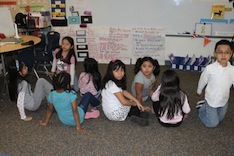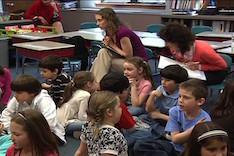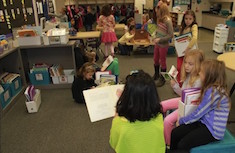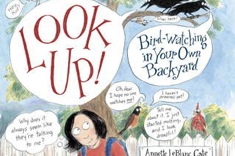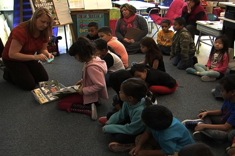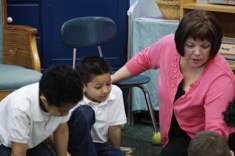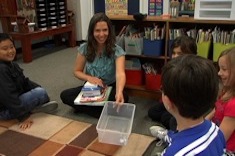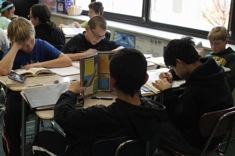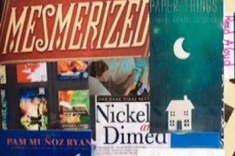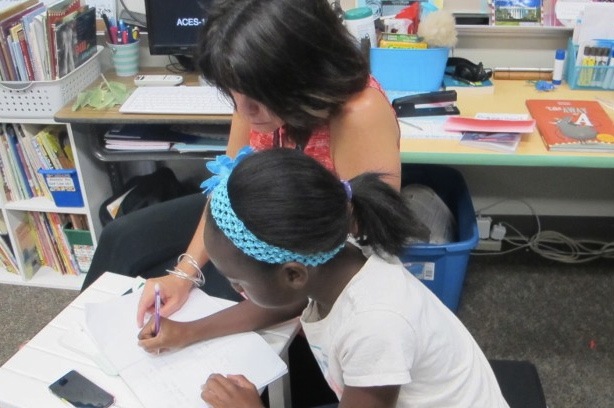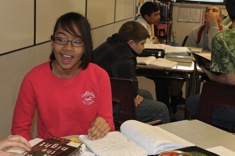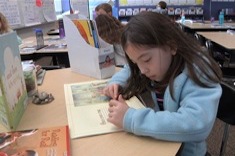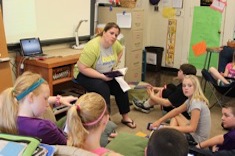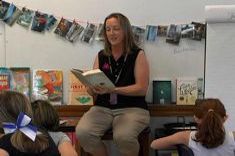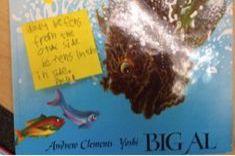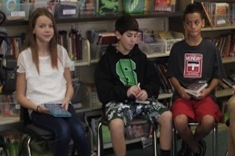Teaching Reading
Our contributors lead reading workshops in classrooms with creative flair. Over the past 12 years, we've filled our site with loads of suggestions, tools, and tips for using engaging books throughout the curriculum to hook kids on reading. Here is where you will find many stories of successful and not-so-successful workshop days, and what we learned from them. We bring these stories to life through hundreds of video examples.
Latest Content
Mid-Workshop Conversations
Stella Villalba finds mid-workshop conversations are a terrific routine to add to literacy workshops to promote growth, especially for English language learners.
Little Levels, Big Thinking
Katie DiCesare moves beyond levels to consider her first-grade readers’ needs.
Reading, Engagement, and Kidwatching
Katrina Edwards looked around her first-grade reading workshop one day in winter and it wasn’t a pretty picture. Many students were doing anything but reading. She develops a plan to approach the issue of time on task thoughtfully.
Unstable Labels: Stop the Race to Z
Jan Burkins and Kim Yaris consider the insignificance of what levels convey about young readers.
Nonfiction Books with More Than One Entry Point
Franki Sibberson shares some of her favorite nonfiction books with more than one entry point.
Nonfiction Scrapbooks
Justin Stygles finds Nonfiction Scrapbooks are a fun way for his fifth-grade students to explore their reading interests and artistic talents with the classroom community.
Understanding Fiction and Nonfiction in First Grade
This is a demonstration lesson in a first-grade classroom on understanding the difference between fiction and nonfiction led by Erin Quealy. It is the first video in a three-part series.
Grouping Strategies for Guided Reading
How can you support the “outliers” in classrooms — students with unique needs or profiles who don’t neatly fit into any instructional group? Shari Frost offers some strategies.
Second-Grade Reading Group
Heather Rader demonstrates the importance of a varied reading diet to a second-grade group, sharing her own stack of books.
Beyond Explicit Instruction: What Do Struggling Readers Need?
Franki Sibberson explores the varied needs of young readers and writers.
Using Reading Notebook Covers for Reflection and Goal Setting
Clare Landrigan and Tammy Mulligan are using reading notebook covers in ingenious ways.
Data That Matters
What information is gathered by a teacher sitting in a rocking chair quietly watching her students? Christy Rush-Levine discovers it is plenty.
Staying True to Best Practices with Required Resources
Are you required to use a reading or writing program that goes against your beliefs about teaching and learning? Gigi McAllister has suggestions for holding onto your beliefs and sanity.
Conferring with Boys in Sixth Grade
Katie Doherty confers with boys in her sixth-grade reading workshop. This is the second installment in a two-part video series.
Conferring with Boys in Middle School
Katie Doherty circulates among sixth-grade boys in her reading workshop. These quick conferences and conferring tips are the first installment in a two-part series.
Speed Dating Books
Carly Ullmer presents a fun activity for introducing teens to new books and each other as readers, capitalizing on their interests.
Just Reading?
Christy Rush-Levine challenges the notion that there is anything easy or natural about getting young teens to select and read books independently in classrooms.
Doodlebug
What makes a teacher memorable? Recognizing a child's passions from the very first day of school. Jennifer Schwanke recounts how her second-grade teacher did just that.
Reading Workshop Routines in First Grade
Bitsy Parks explains the routines and procedures in her first-grade reading workshop.
Read Alouds as “Third Things”
Katherine Sokolowski uses read alouds early in the year to help students reflect on how to be kind and thoughtful members of a classroom community.
Bring Back Read Aloud
Jennifer Schwanke interviews older students and discovers their most beloved memories of elementary school involve read alouds.
Strategies for Using Reader’s Notebooks
Melanie Swider enhances read alouds and the entire reading workshop with creative uses for reading notebooks.
Fourth-Grade Read Aloud: Checking In
In this video from a fourth-grade classroom, Gi Reed reads aloud Small as an Elephant by Jennifer Richard Jacobson. Gi continually checks in with her students, making sure they are visualizing, noticing new vocabulary, and making connections to earlier incidents in the texts—all without breaking the flow of the story.
Using a Strategy Card in a Reading Conference
Deb Gaby confers with second grader Reagan early in the school year. She is reading her first chapter book, and using a reading strategies “tool kit” for support.
Anchoring Language
Katie DiCesare thinks about what language supports student independence early in the year and how to share this in an anchor chart with her first graders.
Book Clubs Then and Now: Change Is the Constant
Mary Lee Hahn considers how book clubs have changed over time in her fifth-grade classroom.
Getting to Know a Young Reader
As she confers with first grader Kendall, Deb Gaby skillfully weaves questions about home and reading together.
Provoking Young Readers
Melanie Meehan finds read aloud is a great time for children to connect opinions and experiences.
Questioning Questions: Rethinking Prompts for Reading Conferences
Jan Burkins and Kim Yaris are rethinking questions used in one-on-one reading conferences.
Digital Literacy Workshop
Maria Caplin has suggestions for making transitions to digital literacy in reading and writing workshops.
Browse Content By
Type
Category
- Assessment Tools
- Big Fresh Archives
- Booklists
- Choice Numeracy
- Classroom Design
- Common Core
- Community Building
- Conferring
- Content Literacy
- Digital Literacy
- English Language Learners
- Equity
- Family Relations
- Free Samples
- Guiding Groups
- Leadership
- Literacy Coaches
- Mentor Texts
- Minilessons
- New Teacher Mentors
- Podcasts
- Poetry
- Quote Collections
- Reading Strategies
- Self Care
- Struggling and Striving Learners
- Talking and Listening
- Teacher Study Groups
- Teaching Reading
- Teaching Writing
- Word Study and Vocabulary
Author
- Melissa Quimby
- Nawal Qarooni
- Gwen Blumberg
- Julie Cox
- The Lead Learners
- Hannah Tills
- Josie Stewart
- Ruth Metcalfe
- Mallory Messenger
- Becca Burk
- Jodie Bailey
- Vivian Chen
- Mary Brower
- Tiffany Abbott Fuller
- Stephanie Affinito
- Ruth Ayres
- Leigh Anne Eck
- Heather Fisher
- Shari Frost
- Julie Johnson
- Suzy Kaback
- Gigi McAllister
- Shirl McPhillips
- Melanie Meehan
- Cathy Mere
- Debbie Miller
- Tara Barnett and Kate Mills
- Tammy Mulligan
- Dana Murphy
- Bitsy Parks
- David Pittman
- Brenda Power
- Heather Rader
- Matt Renwick
- Mandy Robek
- Christy Rush-Levine
- Gretchen Schroeder
- Jen Schwanke
- Brian Sepe
- Katherine Sokolowski
- Stella Villalba
- Jennifer Vincent
Grade Level
Choice Literacy Membership
Articles
Get full access to all Choice Literacy article content
Videos
Get full access to all Choice Literacy video content
Courses
Access Choice Literacy course curriculum and training

